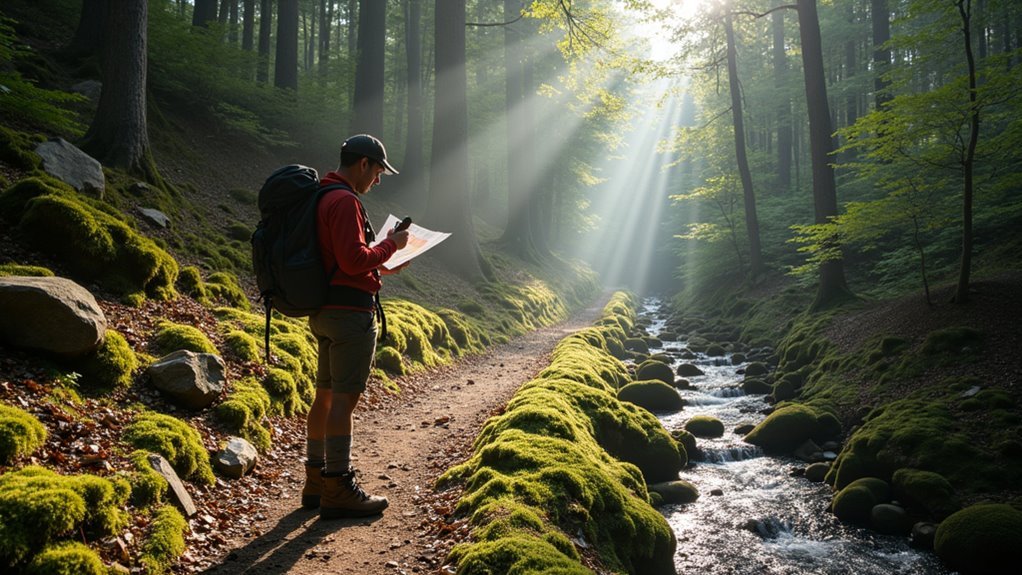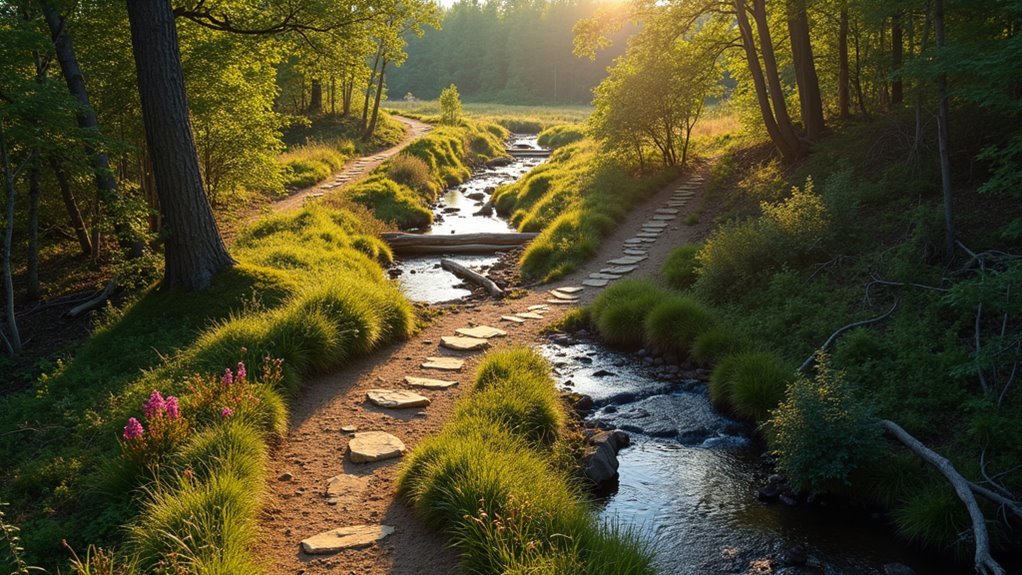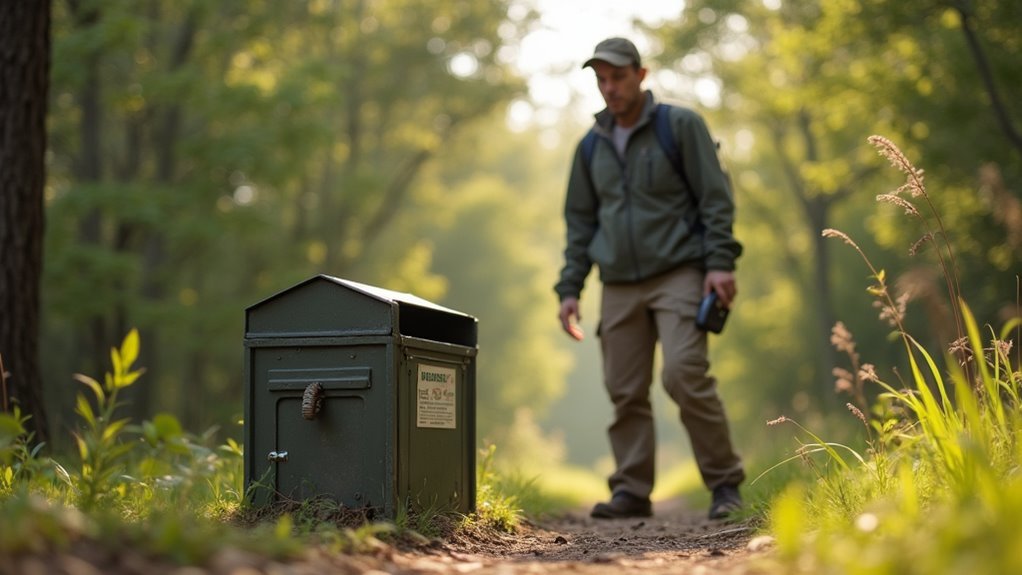Some of the links in this article may be affiliate links. If you make a purchase through these links, we may earn a small commission at no extra cost to you. Thank you.
I’ve seen so many new cache owners struggle with this exact issue – how do you properly rate the difficulty of your hide? Trust me, I’ve made this mistake myself when I first started. The difficulty rating isn’t about how easy it seems to you (after all, you know exactly where it is!), but rather how challenging it’ll be for a first-time finder. It’s actually one of the most impactful decisions you’ll make when publishing your cache, and here’s why…
Understanding the Difficulty and Terrain (D/T) Rating System

How exactly do you know what you’re getting yourself into when you head out for a geocaching adventure? The answer lies in the Difficulty and Terrain (D/T) rating system – your GPS-guided roadmap to what awaits.
When cache owners create a hide, they assign subjective ratings from 1-5 for both intellectual challenge (Difficulty) and physical access (Terrain).
Every geocache comes with two vital clues: a Difficulty rating for your brain and a Terrain rating for your body.
Think of Difficulty as the mental workout your brain needs, while Terrain reflects the physical effort required to reach the cache.
I’ve found it’s always better to rate a bit higher if you’re unsure.
Nobody likes arriving at what they thought was an easy 1.5 terrain cache only to discover it requires rock climbing!
Factors to Consider When Assigning Difficulty Ratings
Deciding on the right difficulty rating for your geocache involves balancing several key factors that’ll make or break a finder’s experience.
Always rate from the finder’s perspective, not how easy it was for you to hide. I’ve found that it’s better to round up when in doubt—underrating frustrates searchers more than overrating.
For puzzle writers, remember to account for both the mental challenge of solving and the physical act of finding.
When I review my own caches, I try to imagine someone unfamiliar with the subject matter tackling it.
Don’t rely solely on your judgment! Seek feedback to assess your rating’s accuracy.
Maybe ask beta testers for their opinions, or better yet, calculate the median of several reviewers’ suggested ratings.
This approach has helped me create more accurate difficulty scores.
Terrain Rating Guidelines and Physical Challenges

While difficulty ratings focus on the mental challenge, terrain ratings deal with a whole different beast—the physical demands of finding a cache.
When I’m setting up a new geocache with my GPS devices, I always consider the varying physical abilities of potential finders.
Here’s what I factor in when assigning terrain ratings:
- Accessibility – Is it reachable by car or does it require a 5-mile hike? I’ll bump a rating from 1.5 to 3.5 if hiking’s necessary.
- Seasonal changes – A boardwalk removal can transform a T2 into a T4 overnight.
- Vehicle requirements – Needing a 4×4 versus a regular car should be reflected in your rating.
- Finder variations – What’s easy for an ultra-runner might be impossible for others.
When in doubt with Global Positioning Systems guidelines, I always rate terrain upward.
Puzzle Cache Considerations: Rating Mental and Physical Components
The puzzle caches pose a unique challenge when it comes to assigning difficulty ratings.
Unlike traditional hides where your GPS device leads you straight to the spot, these require mental gymnastics before you even activate the Global Positioning features.
In my experience, it’s best to evaluate both components separately at first.
I initially rated my flags-themed puzzle a 4.0, but later realized I’d overestimated the difficulty since Google makes many puzzles easier than I thought.
When creating puzzle caches, I recommend getting feedback from beta testers—their median rating usually gives you a more accurate picture.
Common Rating Mistakes to Avoid

Why do so many geocache owners miss the mark when rating their hides?
In my experience, it’s because we’re too familiar with our own caches!
When I hide something, I already know where it is, so it seems easier to me than to someone encountering it for the first time.
Here are the most common rating mistakes to avoid:
- Rating based on your own physical abilities rather than the average finder’s experience
- Underestimating puzzle difficulty because you created the solution
- Not accounting for seasonal changes that affect terrain difficulty
- Failing to review any feedback from early finders
If you’re unsure, consult the Geocaching Help Center and Guidelines.
Seasonal Changes and Environmental Factors
Seasonal cache ratings present one of geocaching’s trickiest challenges—what’s a straightforward terrain 2 in summer might become an expert-level terrain 4 in winter!
When I’m planning a hide, I’ve learned to evaluate how the environment transforms throughout the year. Your GPS unit might lead cachers to the same coordinates, but the journey there changes dramatically with the seasons.
| Season | Factor | Impact | Rating Adjustment | Example |
|---|---|---|---|---|
| Winter | Snow/Ice | Blocked paths | +1 to +2 | Forest trail becomes snowshoe route |
| Spring | Flooding | Limited access | +1 to +3 | Creek crossing becomes swim |
| Summer | Vegetation | Overgrowth | +0.5 to +1 | Clear path becomes bushwhack |
| Fall | Leaf cover | Hidden hazards | +0.5 | Visible rocks become slip hazards |
| Any | Structure removal | Changed access | +2 or more | Boardwalk removal requires wading |
Global Positioning might be constant, but the terrain certainly isn’t!
Adjusting Ratings Based on Finder Feedback
How should cache owners respond when multiple logs suggest their difficulty rating is off the mark?
When finders share your thoughts about difficulty mismatches, I believe it’s worth considering adjustments.
Based on my experience with community feedback, here’s what I’d suggest:
- Assess if a feature was overlooked or overestimated in your original rating
- Consider making changes early in a cache’s life (the first few weeks) to prevent disruption to finder statistics
- Weigh multiple reports against your intended challenge level
- Only adjust ratings when there’s clear consensus, not just one person’s opinion
I’ve seen how rating changes can impact physigrid completions and DT challenges.
If you’re unsure, maybe reach out to an experienced cacher before making changes that might affect the community’s stats.
Rating Special Cache Types: Multi-Caches, Wherigos, and More
Rating special cache types presents unique challenges that often leave cache owners scratching their heads.
I’ve found that multi-caches should be rated based on the cumulative challenge of all stages, not just the final hide.
Rate multi-caches on the total challenge presented by all stages, not merely where the final container is hidden.
When I’m uncertain, I’ll add a half-star to avoid underwhelming finders.
For puzzle caches, I initially consider both the intellectual and physical components.
I rated my flags-themed puzzle 4.0, but after feedback that Google made it easier, I adjusted downward.
That’s totally normal!
Wherigos need special consideration too.
As discussed in the Help Center for Adventure Lab, you’ll want to assess cartridge complexity alongside physical navigation.
The Adventure Lab Builder Guide and Adventure Lab Guidelines offer similar principles—rate for the overall experience, not just individual elements.
The Impact of Accurate Ratings on the Geocaching Experience
Now that we’ve explored how to rate those tricky special cache types, let’s talk about why getting these ratings right actually matters in the real world.
I’ve seen firsthand how accurate ratings can make or break a caching experience.
During discussions about Global Positioning, I often hear complaints about mismatched expectations.
Ask your fellow geocachers and you’ll hear similar stories!
Here’s why accuracy matters:
- It prepares finders for what they’ll actually face instead of surprising them with unexpected challenges
- It prevents frustration when a supposed “easy” cache requires special equipment
- It protects cachers’ statistics and achievements (no one wants to lose a hard-earned DT square!)
- It helps new cachers properly track their Trackable inventory on cache logs
Frequently Asked Questions
What Do C and D Mean in Geocaching?
In geocaching, I use D for Difficulty (intellectual challenge) while C isn’t a standard abbreviation in historical ratings. D originated in the original 1-5 rating system, unlike other hobby abbreviation origins.
What Do the Question Marks Mean on Geocaches?
I’d explain that question marks indicate Mystery Variations of geocaches, where you’ll solve puzzles before finding the physical container. This Symbol Interpretation means intellectual challenges await, requiring clever Puzzle Strategies to succeed.
How to Use Proper Geocaching Etiquette When Hiding or Seeking a Cache?
I always obtain permission before hiding caches on private land, stick to established trails when seeking, and promptly report or fix maintenance issues to keep geocaching sustainable for everyone.
What Does D/T Mean in Geocaching?
Did you know 81% of geocachers consider D/T ratings essential? In geocaching, D/T means Difficulty/Terrain ratings. I’ve seen D/T history evolve from simple guidelines to complex rating comparisons reflecting terrain variations from sidewalks to mountaineering.